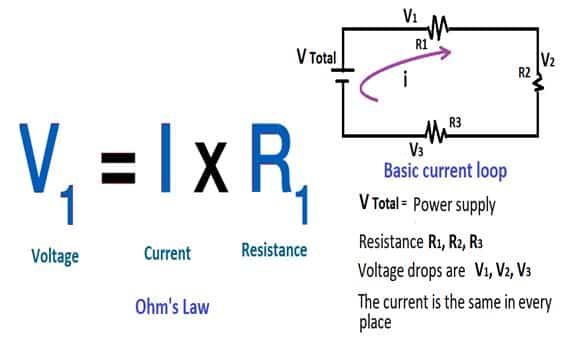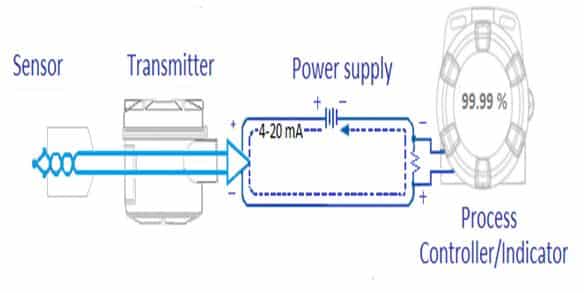In this post, we will discuss what is a 4-20 mA current loop & its advantages and disadvantages. The 4-20 mA current loop is the standard for signal transmission.
We use different types of signals in the world of process control. Resistance Temperature Detectors (RTDs), and Thermocouples provide direct temperature readings. On the other hand, digital signals such as Modbus provide accurate control of process variables and their display.
Analog signals through which the process information is transmitted have different levels of voltage or current. The 4-20 mA current signal is most used today in industries that require process control.
In order to transmit information of process variable (PV), the analog signal, 4-20 mA current loop is the prevalent standard in the industry. Although, this standard is one of the main ones in the process control industry, in this article, let us discuss and understand the fundamentals of its configuration and use.
How Does a 4-20 mA Current Loop Work?
To understand what a 4-20 mA direct current (DC) loop is and how it works, we need to know a relation between voltage, current, and resistance.
The formula we need is somewhat simple: V = I x R. This is Ohm’s Law. What it indicates is that the voltage or voltage (V) is equal to the current intensity (I) multiplied by the resistance (R). This is a fundamental equation in electrical engineering.
Consider the DC circuit below, which consists of a power supply and three loads. A current loop requires voltage to produce current, it is provided by the power supply, indicated as “V Total” in the diagram.
The current then flows through the loop, passing through each load. Using Ohm’s law, we can calculate the voltage drop across each load. Across resistance R1 the voltage drop V1 is

Components of a 4-20 mA Loop
Let us begin to understand exactly how the loop works. As shown in the below figure, a physical wire is connected across the sensor, transmitter, power supply, and receiver. The receiver can be a DCS controller or indicator.
1. Sensor
First of all, there must be some kind of sensor that measures a process variable. A sensor typically measures temperature, humidity, flow, level, or pressure, and so on. The technology incorporated into the sensor greatly varies. It depends on the design of the sensor for a particular measurement.
2. Transmitter
Second, regardless of whatever the sensor is monitoring, there must be a way to convert the measurement to a current signal, between 4 and 20 milliamps. This is where the transmitter comes into play.

3. Power supply
There must be a source of power to generate a signal. It is just as in the water system analogy where there must be a source of pressure.
There are many common voltages 9V, 12V, 24 V, that we use with the 4-20 mA current loops depending on the required configuration.
4. Loop
In addition to a suitable power supply, there must also be a loop. The loop especially refers to the wire connecting the sensor to a receiver that receives the 4-20 mA signal and then returns to the transmitter. In the loop, as per the sensor measurement, the current signal in the range of 4-20 mA is regulated accordingly by the transmitter.
5. Receiver
Finally, the receiver is a device somewhere in the loop that can receive and read the current signal. This current signal should be translated into units easily understood by operators. Digital displays, controllers, actuators, and valves are common pieces of equipment that are attached to a loop.
These components are all that is necessary to complete a 4-20 mA current loop. Sensors measure the process variable, whereas the transmitter converts the corresponding measurement into a current signal. Through a loop of wire, the current signal passes to a receiver, and the receiver displays or performs an action on that signal.
Summary of 4-20 mA Current Loops
The 4-20 mA current loop is the main process control signal in many industries. It is an excellent method of transmitting process information because the current does not degrade with a distance of travel.
Advantage
- The 4-20 mA current loop is the general standard in many industries.
- It is an easy option to connect and configure.
- It uses very fewer connections and wiring than other signals, enormously reducing costs.
- 4-20 mA signal is best for traveling long distances, current does not reduce as voltage does.
- The current signal is less sensitive to electrical noise.
- Since 4 mA equals 0% of a signal, it becomes easy to detect a fault in the system.
Disadvantages
- The current loop is limited to transmitting a single particular process signal.
- For each process variable, there must be separate 4-20 mA current loop. Therefore, the number of 4-20 mA loops are more if process variables are more. Independent loops are needed to be properly insulated, otherwise it can cause problems with the ground loops.
- These isolation requirements become substantially more complex as the number of loops increases.